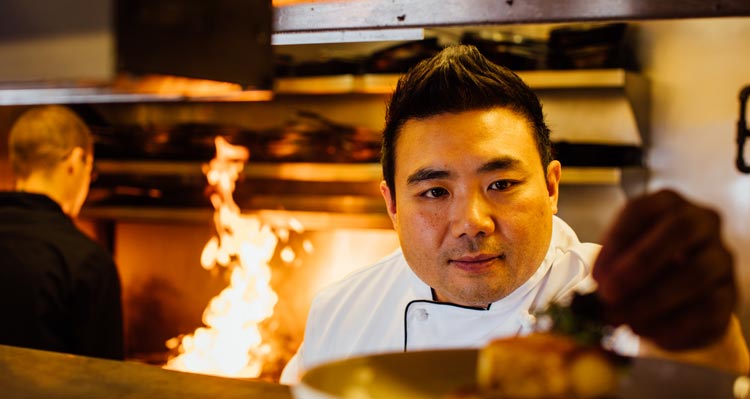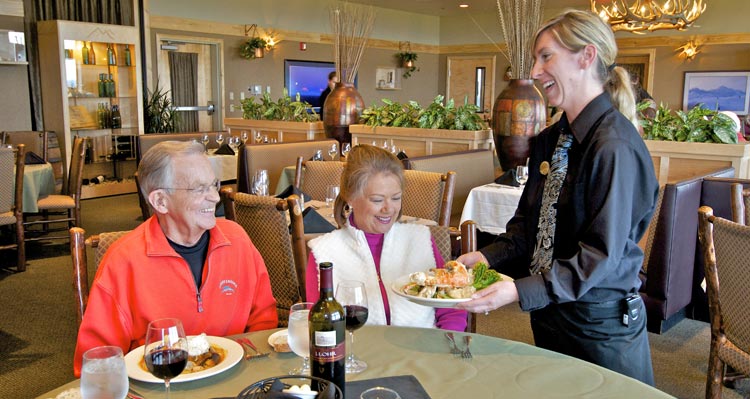Working as a chef in Alaska has its pros and cons. One con, of course, is the great distance from many suppliers in the Lower 48. But the pros of outstanding and local seafood definitely outweigh the distance. In Alaska, local is divine.
"All the fresh seafood here definitely keeps me stimulated," says Chef Wes Choy, director of food and beverage for Pursuit’s Alaska Collection. Chef Choy has worked in kitchens across the continent and around the world, including at the Foraker Restaurant in Talkeetna Alaskan Lodge. And although it's practically impossible to ask a chef for their favorite all-time meal, Chef Choy joins the chorus and says if he had to pick one, "of course it would be Alaskan red king crab. There is no substitute to having freshly prepared Alaskan king crab that was caught right off the shores of Alaska."
The rise of television programs like Deadliest Catch has heightened interest in Alaska king crab — shining a spotlight on how hard it is to catch and how exclusive it is to actually enjoy it on your plate.

But it's about more than pop culture. Alaska king crab is an incredibly rewarding choice for its flavor alone.
"From a taste standpoint, king crab really stands alone," he says. "I don't think we ever get someone disappointed in this meal. If you've had it, you love it."
Chef Choy says there are three reasons Alaska king crab is so good. First, it's way bigger than any other crab out there. And yet it's much more delicate and soft in appearance. It's loaded with what Chef Choy describes as a "sweetness and meatiness" unlike any other crab meat in the world.
Then, there's the health factor — it's a leaner protein than other crab meats, low in both fat and calories. It comes in at around 100 calories and 19 grams of protein per 100 grams of meat. Alaska king crab is rich in high-quality protein and omega-3 fatty acids. It's good for your heart, muscles, joints, eyes and even your brain!

Finally, thanks to popular culture, diners now understand how king crab is harvested, and how dangerous and complicated it was to just get it on your plate. King crab fishing is considered one of the most dangerous jobs in America. And it's actually very sustainable as well.
Chef Choy explains that Alaska implements stringent catch rules and stock rebuilding plans which limit the total allowable catch to a small fraction of the adult male king crab population. There's only so much of it available. Travelers need to be on the lookout to make sure that the king crab they're ordering while in Alaska is actually from Alaska (versus a lower-quality Russian crab that, accodring to Choy, is appearing more and more). When it's the real deal, its allure is hard to resist, like a taste of wild Alaska.
"I love that Alaska king crab is always wild caught, harvested in the pristine and hazardous waters off Alaska's coast," he says. "The romanticism of the adventure and struggle to harvest Alaska king crab never wanes for me."
Sure, it can be challenging (some might say "messy") to eat, but Chef Choy says preparing Alaska king crab properly is actually quite simple.
When it’s on the menu at Foraker, the team carefully steams the Alaska king crab legs whole to maintain moisture. Preparing the legs whole allows the crab meat to cook in its own juices, which results in a more succulent flavor, Choy says. Then, the team splits the legs so guests don't get too messy. It's then plated alongside local root vegetables that are seasonally available, rice or potatoes, some lemon and a big bowl of melted butter.
The butter adds umami taste and savoriness to it, and a side of lemon adds acidity — both key in enhancing the king crab's flavor.
That sweet, juicy meat dipped in butter is Chef Wes Choy's go-to recommendation.
Keep an eye on our online menus and social media to see if Alaska king crab is available at the Talkeetna Alaskan Lodge’s Foraker Restaurant during your visit. Then, stop in and try a taste of wild Alaska for yourself.
Insider tips, inspiration and deals — delivered straight to your inbox.
"From a taste standpoint, king crab really stands alone. I don't think we ever get someone disappointed in this meal. If you've had it, you love it."